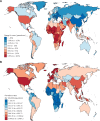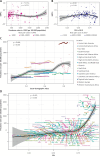Temporal trends in neck pain prevalence among adolescents and young adults aged 10-24 from 1990 to 2019
- PMID: 40395879
- PMCID: PMC12087321
- DOI: 10.5114/aoms/190029
Temporal trends in neck pain prevalence among adolescents and young adults aged 10-24 from 1990 to 2019
Abstract
Introduction: Neck pain is common among adolescents and young adults, affecting their health and well-being. However, research on its prevalence trends in this demographic is limited despite its global significance.
Material and methods: Data from the Global Burden of Disease Study were used to analyze neck pain prevalence and trends among individuals aged 10 to 24 from 1990 to 2019. Temporal trends and regional differences were assessed using estimated annual percentage changes.
Results: Globally, the number of adolescents and young adults affected by neck pain increased from 11,594,119 cases in 1990 to 12,880,134 in 2019. Despite this increase, the prevalence rate stabilized, dropping from 74,850.57 per 100,000 individuals in 1990 to 69,178.4 per 100,000 in 2019, with an annual decrease of -0.28%. In 2019, prevalence rates for ages 10-14, 15-19, and 20-24 were 31,624.66, 69,189.45, and 109,351.52 per 100,000 individuals, respectively. The regions with the highest prevalence rates in 2019 were Western Europe, high-income North America, and Southeast Asia, with rates of 1938.57, 1930.2, and 1021.37 per 100,000 individuals, respectively. Nationally, the United Kingdom, Denmark, and Finland had the highest rates: 2,487.30, 2,442.03, and 2,336.94 cases per 100,000 individuals, respectively. Notably, regions with higher Socio-Demographic Index (SDI) levels tended to have higher prevalence rates of neck pain among adolescents and young adults, with variation by region and age group.
Conclusions: The study emphasizes the ongoing burden of neck pain among adolescents and young adults worldwide, emphasizing the necessity for targeted interventions to enhance public health outcomes in this group.
Keywords: Global Burden of Disease; adolescents; neck pain; prevalence; young adults.
Copyright: © 2024 Termedia & Banach.
Conflict of interest statement
The authors declare no conflict of interest.
Figures




Similar articles
-
Global, regional and national burdens of acne vulgaris in adolescents and young adults aged 10-24 years from 1990 to 2021: a trend analysis.Br J Dermatol. 2025 Jan 24;192(2):228-237. doi: 10.1093/bjd/ljae352. Br J Dermatol. 2025. PMID: 39271178
-
Global, regional, and national burdens of heart failure in adolescents and young adults aged 10-24 years from 1990 to 2021: an analysis of data from the Global Burden of Disease Study 2021.EClinicalMedicine. 2024 Dec 9;79:102998. doi: 10.1016/j.eclinm.2024.102998. eCollection 2025 Jan. EClinicalMedicine. 2024. PMID: 39737218 Free PMC article.
-
Burden of and Trends in Urticaria Globally, Regionally, and Nationally from 1990 to 2019: Systematic Analysis.JMIR Public Health Surveill. 2023 Oct 26;9:e50114. doi: 10.2196/50114. JMIR Public Health Surveill. 2023. PMID: 37883176 Free PMC article.
-
Global burden trends and forecasts for MAFLD in adolescents and young adults from 1990 to 2021.Sci Rep. 2025 Apr 19;15(1):13534. doi: 10.1038/s41598-025-98489-9. Sci Rep. 2025. PMID: 40253566 Free PMC article.
-
Global, regional, and national burden of asthma and atopic dermatitis, 1990-2021, and projections to 2050: a systematic analysis of the Global Burden of Disease Study 2021.Lancet Respir Med. 2025 May;13(5):425-446. doi: 10.1016/S2213-2600(25)00003-7. Epub 2025 Mar 24. Lancet Respir Med. 2025. PMID: 40147466
References
-
- Mazaheri-Tehrani S, Arefian M, Abhari AP, et al. . Sedentary behavior and neck pain in adults: a systematic review and meta-analysis. Prev Med 2023; 175: 107711. - PubMed
-
- Hvedstrup J, Kolding LT, Ashina M, Schytz HW. Increased neck muscle stiffness in migraine patients with ictal neck pain: a shear wave elastography study. Cephalalgia 2020; 40: 565-74. - PubMed
LinkOut - more resources
Full Text Sources
